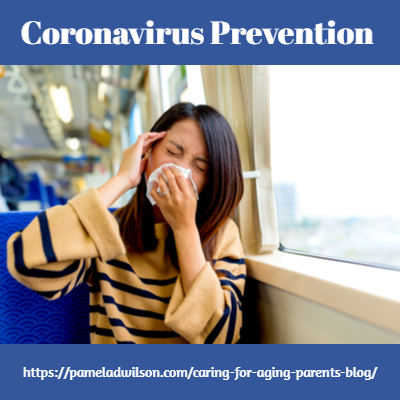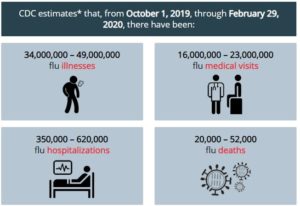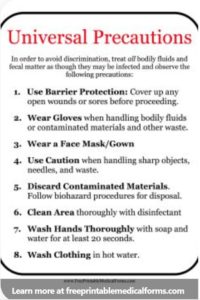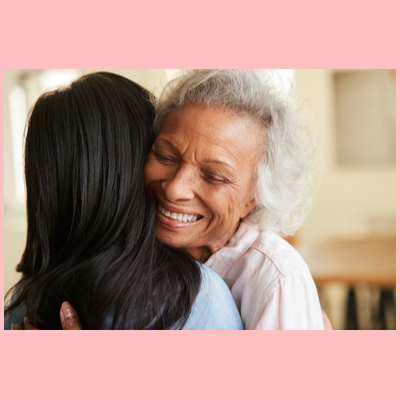Caregiving Blog: Coronavirus

Coronavirus prevention involves taking simple steps to protect yourself in healthcare settings, in the workplace, and at home. According to the CDC, the coronavirus (COVID-19) spreads through person-to-person contact within 6 feet or less. Individuals with chronic diseases and poor immune systems are more susceptible to viruses. Sneezing and coughing are the primary modes of transmission.
Worries about acquiring the coronavirus mount as new cases of the virus are publicized every day in the media. Respiratory drops from sneezing and coughing travel from person to person. The drops can land in the mouths or noses of people who are nearby. Inhaled coronavirus droplets travel into the lungs. Touching the face, mouth, nose, or eyes transmits the virus. Less possible, but still under investigation by the CDC, is infection from touching a surface or object where the virus resides.
Coronavirus, Pneumonia, Norovirus and Flu Prevention
While the coronavirus is top of mind because of world news, other viruses like pneumonia, norovirus, and the flu are common in the United States. Shared here is background about the coronavirus, pneumonia, norovirus, and flu prevention tips to provide a balanced perspective.
For healthcare workers and consumers, learning about health, well-being, practical tips, and reviewing universal precautions for preventing the spread of all infections are the best way to avoid acquiring or transmitting any virus. Consumer participation in all aspects of health and well-being is essential to prevent chronic diseases.
Steps Toward Health Prevention
Tips about aging adults, caring for elderly parents, and caregiving are on my radio program, The Caring Generation®, and the radio show podcasts. Consumers must be proactive in supporting health and well-being. The healthcare system exists to treat diseases after a virus, a heart attack, or another diagnosis happens. Prevention is a consumer responsibility.
Consumers build confidence in the ability to achieve good health by taking action to become educated and engaged patients. Seeking education about the coronavirus, chronic diseases, and preventative measures reduce the fear that spreads from misinformation. Caregivers for elderly parents bear the responsibility of becoming more educated about healthcare and self-care. Caregivers easily become exhausted and experience health problems.
When we look at the coronavirus in the broader context of the response of the United States, consumers can make choices about preventative actions to take in their daily lives. Healthcare workers can be more proactive about prevention, protecting their health, and taking precautions when working in medical care settings.
Coronavirus: What Is It? Should We Be Worried?
Pamela D. Wilson, caregiving expert, shares information about the coronavirus, pneumonia, flu, and the norovirus that most consumers don’t know.
Coronavirus and Pneumonia
The coronavirus can lead to pneumonia. Pneumonia is an infection of the lungs caused by a virus. According to E-Medicine Health (1), the viral infections of H1N1 swine flu and severe acute respiratory syndrome (SARS) were caused by a virus in the coronavirus family. Viral pneumonia is life-threatening for elderly and young persons with weak immune systems. The coronavirus can be mild for most people who do not have chronic diseases or vulnerable immune systems.
Symptoms of viral pneumonia include a persistent cough, shortness of breath, chest pain, coughing up blood, vomiting, and being unable to eat or drink. Anti-biotics are not a cure for viral pneumonia. Lack of antibiotic treatment is the reason pneumonia can be life-threatening for the elderly who have chronic diseases or persons with weak immune systems. A pneumonia vaccination can be a preventative step to staying healthy for the elderly.
The 1918 Flu (H1N1 virus) Pandemic to Today
Going back over 100 years ago to 1918-1919, the United States experienced one of the most significant flu outbreaks from an avian virus. According to the CDC (2), about 675,000 deaths occurred in the United States with 50 million deaths worldwide.
 Precautions during this pandemic included isolation, quarantine, recommendations for good hygiene that today we call universal precautions, using disinfectants, and limiting large public gatherings. What have we learned since then? (3)
Precautions during this pandemic included isolation, quarantine, recommendations for good hygiene that today we call universal precautions, using disinfectants, and limiting large public gatherings. What have we learned since then? (3)
The United States is more prepared about prevention than other countries. Flu and pneumonia vaccinations are available and recommended, especially for the elderly and persons with weak immune systems. This chart shows recent statistics from the CDC for the flu.
Hand Hygiene Can Reduce Viruses
These common-sense prevention tips apply to everyone consistently, not only related to fear of acquiring the coronavirus but for supporting health and well-being. Washing hands for 20 to 30 seconds thoroughly with soap and water is one of the best precautions to avoid transmitting or acquiring a virus. If you are not aware of the proper way to wash hands, watch this video from the CDC that stresses the importance of washing hands in the hospital and all settings.
Hand Hygiene Saves Lives (5)
In addition to hand hygiene, if you sneeze or cough, hold a handkerchief or a tissue over your mouth. If you don’t have a handkerchief or a tissue, sneeze into the upper arm of a jacket or a shirt to prevent droplets from spreading into the air. Wash your hands frequently and avoid touching your face.
Hospitals and the Elderly
Consumers may be wondering about postponing elective hospital procedures due to concerns about the potential spread of the coronavirus throughout hospital systems. Postponing medical procedures is a personal decision. In my experience before any type of elective surgery, if al all possible, a person should be in good physical condition to have the best possible outcome.
Hospitalizations for elderly individuals result from chronic disease, weakened immune systems, poor nutrition, and physical weakness. When severe health conditions exist, hospitalizations cannot be postponed. If you are concerned about admission to a hospital and the coronavirus, talk to a doctor.
Malnutrition is a concern in nearly 47% of elderly living in the community and elderly living in care communities. The effect of poor nutrition is not a condition evaluated by primary care physicians. Poor diet contributes to chronic disease and weak physical strength that combine to make recovery from viruses and other illnesses more difficult for the elderly.
Family caregivers are surprised to learn about the effect of chronic disease on the ability of elderly parents to stay at home. An adult child may be a medical power of attorney and lack understanding of their role and responsibility.
More information about Warning Signs for the Elderly and Nutrition can be found on The Caring Generation® radio program featuring Dr. Nicolaas Deutz.
 Hospitalizations should offer the opportunity to employees, visitors, and patients for the screening of the coronavirus until concerns have passed about the spread of the virus. While progress is underway to identify a vaccine for the coronavirus, because of testing requirements, a vaccine may not be available for 12-18 months. (6) It is unknown whether the coronavirus, like the norovirus, will decrease in frequency during warmer weather months.
Hospitalizations should offer the opportunity to employees, visitors, and patients for the screening of the coronavirus until concerns have passed about the spread of the virus. While progress is underway to identify a vaccine for the coronavirus, because of testing requirements, a vaccine may not be available for 12-18 months. (6) It is unknown whether the coronavirus, like the norovirus, will decrease in frequency during warmer weather months.
Healthcare Worker Concerns About the Coronavirus
Healthcare workers are concerned about acquiring the coronavirus. Persons working in nursing homes hospitals, medical offices, treatment facilities, eldercare communities, and emergency response providers have a high frequency of consumer contact. Requests from healthcare workers asking to utilize infection control procedures for pandemics should be validated.
The opportunity for the screening of the coronavirus should be available to all healthcare workers. Having peace of mind about not having the virus, transmitting the virus to others in the workplace, or passing the virus to family members can reduce the emotional stress of caring for others. Healthcare workers benefit from education and support in the workplace.
The Centers for Medicare & Medicaid Services recently issued several updates. These updates include infection control recommendations for patients with the coronavirus (COVID-19) and persons under investigation. Updates for infection control universal precautions were issued for hospitals and nursing homes. (7,8,9)
Stay at Home
Healthcare communities are approved to screen residents, employees, and visitors. Persons with a respiratory infection, cough, or sore throat are encouraged not to visit or report for work. Testing and isolating individuals with the diagnosis and individuals suspected of having the diagnosis with the virus appears to be one step in the process to stop the spread of the disease.
Care workers, dedicated to caring for others, show up at work sick, creating a risk for the elderly who are more susceptible to simple bugs. Family members may not realize the effect of visiting when sick. Being cautious in all situations, not to transmit viruses to others, or become ill from being in the presence of infected persons helps prevent the spread of disease.
I was adamant with employees not to expose elderly clients to a simple cold or other illness when I operated a home care agency and a care management agency. While young people may recover quickly, a simple bug can turn into pneumonia and pose deadly consequences for an older adult with multiple health concerns.
Universal Precautions
Hospitals and all healthcare workers should be familiar with universal precautions. General precautions include:

- washing hands with soap and water before placing and after removing gloves
- wearing gloves to protect the skin and to avoid exposure to body fluids
- wearing masks, protective eyewear, or face shields during procedures where being exposed to droplets or body fluids is possible,
- wearing gowns or aprons
- using sharps containers for needles and other sharp items
Training on universal precautions as part of state and federal guidelines is required of staff in healthcare communities. But this doesn’t mean that all staff follows the precautions. Doctors, nurses, and CNAs who perform hands-on care are more likely to follow precautions. But what about dietary, cleaning, laundry, groundskeepers, delivery personnel, and other persons who are in and out of the communities?
My visits to clients in hospitals, skilled nursing communities, emergency care clinics, and medical offices confirm that not everyone follows simple precautions like hand washing. Hospitals seem to offer the most thorough precautions. I recall visits with sick clients when I wore a gown, gloves, mask, and eye protection while in the room.
Coronavirus and Nursing Homes
The Lifecare Center of Kirkland, Washington, a 190-bed nursing home facility, is the focus of an investigation into a concerning outbreak of the coronavirus in the United States. A federal disaster team is investigating this nursing home under lockdown. Lockdown means that family members cannot visit.
Elderly and persons diagnosed with multiple chronic diseases are more susceptible to illnesses like the coronavirus, norovirus, pneumonia, and the flu. Hospitals, nursing homes, and care settings have guidelines to follow universal precautions for infection control.
Surveyors from the Centers for Medicare and Medicaid visit healthcare communities to ensure guidelines for infection control and other inspection protocols are in place. Survey results for communities are available on the Medicare Website. (10)
Nursing Home Lockdowns From Virus
Nursing homes and elder care communities can issue lockdown notices, also called no visitation notices for the coronavirus, norovirus, and the flu. The goal is to prevent the spread of incoming viruses from visitors and end contagion for residents.
The norovirus with symptoms of nausea, vomiting, stomach cramps, and watery diarrhea is common in nursing homes during the winter season. Nursing homes go into lockdown mode to prevent the spread of the virus. Visitors to buildings are not permitted, and residents are limited to remain in their hallways rather than having access to common areas.
According to the CDC (11), the norovirus in the United States contributes to:
- 19 to 21 million cases of acute gastroenteritis
- Leads to 1.7 to 1.9 million outpatient visits and 400,000 emergency room visits
- Contributes to 56-71,000 hospitalizations and 570-800 deaths among young children and the elderly
Nursing Home Compare Inspection Reports
Inspection reports from Nursing Home Compare can be reviewed online or printed. Consumers should know that the inspection reports online may be dated. A current copy of the latest survey should be on file at the nursing home. While reviewing inspection reports is helpful, families should visit nursing homes before placing loved ones in a community.
 For more Information about Advocating for the Elderly in Nursing Homes, check out The Caring Generation® podcast.
For more Information about Advocating for the Elderly in Nursing Homes, check out The Caring Generation® podcast.
Even after elderly parents and others are in a care community, family members must be proactive in visiting and advocating for care. The visual appearance of nursing homes and assisted living communities can sway family members to make an inappropriate choice. Nursing homes and care communities with beautiful presentations may have high staff turnover, one indicator of poor care.
Reporting Care Concerns
Family members may not make reports of concern to State Departments of Public Health and Environment. When I was a care manager and a professional fiduciary in the role of a court-appointed guardian, and power of attorney, I initiated complaints to the Department of Health on behalf of my clients.
Families members tell me that they are hesitant to complain about poor care because of fear of retribution by healthcare providers. My conversation with families focused on people who have no one to watch over them. What happens to other residents who may experience similar care issues? An unpleasant reality is that elder abuse and neglect happen within families, in hospitals, nursing homes, and in care communities.
Coronavirus Workplace Tips
Schools are hotbeds of infection for children. The workplace is a hotbed of viruses for working adults. Like in the healthcare system, employees who don’t feel show up for work. Workplaces have requirements for sick employees to provide a doctor’s notice about the illness.
Employees with respiratory infections may not be able to make a timely medical appointment to receive a return to work medical release quickly. Employers may want to consider more leniency if an employee reports respiratory issues as the reason for not reporting to work.
Employees with children who experience respiratory issues should keep children home from school. If sick children show up at school or employees show in the workplace, consideration to isolate ill persons from the healthy might be wise.
Virus Prevention at Home and in the Community
Similar actions should occur in the home when a family member becomes sick. Universal precautions, like hand washing and cleaning surfaces, are essential. If you are a sick person, isolate yourself in a bedroom or another part of the home to reduce the likelihood of spreading the virus to other family members. Avoid visiting the homes of elderly parents if you are sick.
Make sure that you take preventative steps in all areas of health to reduce the likelihood of chronic illnesses and viruses. Talk to your doctor about preventative vaccinations like the annual flu vaccine.
Large Groups Of People
If you are an older adult with chronic disease or a person with a weakened immune system, consider staying away from large groups of people. Discussion is in the news about wearing face masks. Do we or don’t we?
The recommendation by the medical system is to wear a mask if you are sick to protect others. Wearing a mask due to concerns about being infected by others is a personal choice, especially if you are prone to coming down with a virus that takes time to recover.
Consider the Risks of Travel
If you plan to be in an isolated situation like on an airline flight with large numbers of people and recirculating air and you feel more comfortable wearing a mask – wear a mask or some type of face protection. Anyone who frequently flies for business has come in contact with fellow travelers who are sniffling, sneezing, and coughing. According to the World Health Organization (12), airlines have the right to refuse to admit sick travelers on a plane.
Health is a Consumer Responsibility
As individuals in the roles of consumer, patient, caregiver for loved ones, healthcare worker, husband, wife, and more, we must realize that good health is a consumer responsibility. We choose to live a healthy lifestyle or a lifestyle that has potentially adverse effects on our health. Education about health, chronic disease, and well-being exists. Being proactive in embracing positive habits is the way forward to avoid chronic diseases and other illnesses like coronavirus.
Looking For More Help Managing Care for Yourself or Elderly Parents? Check out Episodes of The Caring Generation® Radio Show Here.
Sources:
(1) Schiffman, G and Balentine, J. Viral Pneumonia E Medicine Health. https://www.emedicinehealth.com/viral_pneumonia/article_em.htm#facts_on_viral_pneumonia
(2) 1918 Pandemic (H1Nq virus). Centers for Disease Control. https://www.cdc.gov/flu/pandemic-resources/1918-pandemic-h1n1.html
(3) Jester, B. et. al. Readiness for Responding to a Severe Pandemic 100 Years After 1918. American Journal of Epidemiology. August 9, 2018. Vol. 187, No. 12, DOI: 10.1093/aje,kwy165. https://academic.oup.com/aje/article/187/12/2596/5068408?guestAccessKey=2b05a8ed-3663-45c1-9fb2-96bff3b45f62
(4) 2019 – 2020 U.S. Flu Season Chart. The Centers for Disease Control and Prevention. https://www.cdc.gov/flu/about/burden/preliminary-in-season-estimates.htm
(5) Hand Hygiene Saves Lives. Centers for Disease Control and Prevention. https://youtu.be/BaHTZdJWYVw
(6) Kuchler, H, et. al. Coronavirus and the $2bm Race to Find a Vaccine. Financial Times, March 4, 2020. https://www.ft.com/content/e0ecc6b6-5d43-11ea-b0ab-339c2307bcd4
(7) Interim Infection Prevention and Control for Patients With Confirmed Coronavirus Disease 2019 (COVID-19) or Persons Under Investigation for COVID-19 In Healthcare Settings. Centers for Disease Control and Prevention Coronavirus Disease 2019 (COVID-19) Healthcare Professionals Infection Control https://www.cdc.gov/coronavirus/2019-ncov/infection-control/control-recommendations.html 2/21/2020 Update
(8) Guidance for Infection Control and Prevention Concerning Coronavirus Disease (COVID-19): FAQs and Considerations for Patient Triage, Placement and Hospital Discharge Center. Ref: QSO-20-13-Hospitals CMS. https://www.cms.gov/files/document/qso-20-13-hospitalspdf.pdf-2 March 4, 2020
(9) Guidance for Infection Control and Prevention of Coronavirus Disease 2019 (COVID-19) in Nursing Hhomes Ref: QSO-20-14-NH CMS. https://www.cms.gov/medicareprovider-enrollment-and-certificationsurveycertificationgeninfopolicy-and/qso-20-14-nh.pdf
(10) Medicare.Gov Nursing Home Compare. https://www.medicare.gov/nursinghomecompare/search.html?
(11) The burden of Norovirus Illness in the U.S. Centers for Disease Prevention and Control https://www.cdc.gov/norovirus/trends-outbreaks/burden-US.html
(12) Sampson, Hannah. Can Airlines Force Sick Travelers Off A Plane for Being Sick. The Washington Post, June 28, 2019. https://nationalpost.com/news/world/can-airlines-force-travellers-off-a-plane-for-being-sick
© 2022. Pamela D Wilson, All Rights Reserved.




Trackbacks/Pingbacks